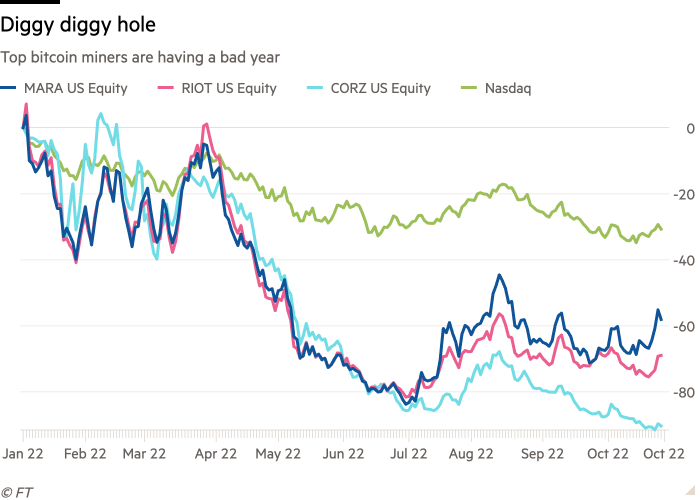The unbearable stability of bitcoin
Bitcoin is doing well, thanks for asking.
Amidst a few months of shaky markets, the world’s favorite cryptocurrency has been remarkably stable, trading in its narrowest range since late 2020:

You may have a different view of this depending on the past, for example if you bought, when and in what amount. Perspectives may include:
It’s also possible that you haven’t followed bitcoin’s daily fluctuations closely because you’re an adult investing in solid assets like UK government bonds.
However you approach it, for a currency that did this during the pandemic –

— the flatness in recent months is a bit… grim.
Volatility is also subdued:

What’s up? Morgan Stanley strategists Sheena Shah and Kinji Steinmetz took a look in a note published Thursday.
Their best takeaway is that most bitcoin entrants since the start of 2021 are currently holding (or HODLing) the bag – and that the tokens themselves don’t move around much:
Almost 1 year into the bitcoin bear market, most who bought bitcoin in 2021 are facing big losses and seem to be waiting for any rally to close their positions. A record number of bitcoin units have not been used for any transaction in the past 6 months, currently at 78% of the total, and this number continues to rise (Exhibit 1).
What this means, if we simplify a bit, is that those who bought/received bitcoin more than 6 months ago are holding their positions and some are probably waiting for a price recovery. For the remaining 22% of bitcoin units held by short-term investors who have traded bitcoin in the past 6 months, estimates suggest their average breakeven price is just over $22.3k (+7% from current, but was as high as 20% a few days ago, see Exhibit 2)
(Shah and Steinmetz note that there are some important caveats here: the first is that it assumes each wallet is owned by a different entity, the second is that it cannot account for transactions outside the blockchain.)
As might be expected, this lack of movement has coincided with a slowdown in activity on most exchanges other than market leader Binance, which has cut fees to boost business and now hosts about a fifth of all volume:
The elephant in the room is, of course, ethereum, which had a publicity boost last month when the blockchain survived an update. Nice! ETH now tracks equity markets more closely than bitcoin, a dynamic that suggests it may be the more normalized risk asset of the two. Some in the market “may now begin to question the … trading dynamics” of bitcoin as a result of ETH’s transition to a proof-of-stake model, Morgan Stanley says.
The analysts note that bitcoin tends to find strong support just above $18,100, suggesting traders are buying dips below this level.
Coverage over the summer identified $20k as a key support level, below which forced liquidations of leveraged positions were required. We would speculate recent dynamics suggest $18k could be a similar pain point. (If you’re a hugely leveraged bitcoin whale, please get in touch.)
Public bitcoin miners, meanwhile, aren’t mining as much, which should also provide some support. Indeed, they are having an extra violent year (even by crypto standards) amid rising energy prices. The share prices of some of the largest IPOs – Marathon Digital, Riot Blockchain and Core Scientific – have been terrible:

(Core Scientific announced it may file for bankruptcy while this article was being written!)
There are circumstances where highly leveraged holders may want this type of stability to be supported by serious, long-term investors holding BTC. Shah and Steinmetz:
As trading volumes fall and there are fewer market participants, intraday traders and market markets have an increasing influence on prices. Their activity is more likely to be influenced by technical price and momentum than, for example, long-term asset managers.
Business-driven bitcoin adoption efforts continue apace, perhaps encouraged by Britain installing its first laser-eyed prime minister. MS’s team is a bit skeptical about how much any of this matters:
In recent months, traditional financial firms have increasingly announced new crypto products to offer their clients exposure to the markets and facilities to buy, sell and hold the underlying crypto…
The companies say they have introduced the products due to customer demand, but looking at the recent flows in and out of exchange-traded products and the trading volume trends described above, we continue to believe that unless there is significant upward price volatility, it may be difficult to see that real demand increases materially.
The stability looks good, at least compared to what is happening elsewhere. But thinning volumes in a market that has no utility beyond value, where the actions of the few active daily participants are determined by technical resistance and support levels, is not a symptom of robust health. While we’re far too jaded to say that the best has come for the mother of all cryptos, its flatlining after the plunge can mean nothing more than that it’s now an asset class on life support.





